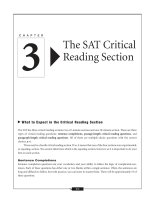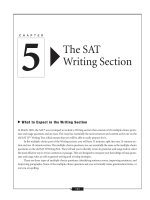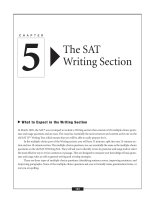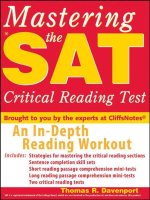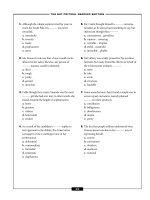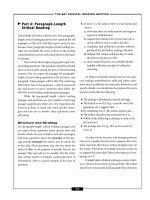The sat critical reading section 9 pps
Bạn đang xem bản rút gọn của tài liệu. Xem và tải ngay bản đầy đủ của tài liệu tại đây (64.7 KB, 6 trang )
Questions 4–8 are based on the following passage about asbestos.
Asbestos is generally made up of fiber bundles that can be broken up into long, thin fibers. We now know
from various studies that when this friable substance is released into the air and inhaled into the lungs over
a period of time, it can lead to a higher risk of lung cancer and a condition known as asbestosis. Asbesto-
sis, a thickening and scarring of the lung tissue, usually occurs when a person is exposed to high asbestos
levels over an extended period of time. Unfortunately, the symptoms do not usually appear until about
twenty years after initial exposure, making it difficult to reverse or prevent. In addition, smoking while
exposed to asbestos fibers could further increase the risk of developing lung cancer. When it comes to
asbestos exposure in the home, school, and workplace, there is no safe level; any exposure is considered
harmful and dangerous. Prior to the 1970s, asbestos use was ubiquitous—many commercial building and
home insulation products contained asbestos. In the home in particular, there are many places where
asbestos hazards might be present. Building materials that may contain asbestos include fireproofing mate-
rial (sprayed on beams), insulation material (on pipes and oil and coal furnaces), acoustical or sound-
proofing material (sprayed onto ceilings and walls), and miscellaneous materials such as asphalt, vinyl, and
cement used to make products like roofing felts, shingles, siding, wallboard, and floor tiles.
–THE SAT CRITICAL READING SECTION–
82
Line
(5)
(10)
4. In line 2, the word friable most nearly means
a. ability to freeze
b. warm or liquid
c. easily broken down
d. poisonous
e. crunchy
5. The main purpose of this passage is to
a. teach asbestos awareness in the home and
schools
b. explain the properties of asbestos
c. encourage preventative measures such as early
lung cancer screening
d. provide a list of materials that may include
asbestos
e. use scare tactics to make homeowners move to
newer houses
6. The word ubiquitous (line 9) and the list of
building materials containing asbestos (lines
11–14) serve primarily to
a. allay fears of becoming ill from asbestos
b. encourage reforms in building practice
c. describe the effects of asbestos in the home
d. urge readers to check their homes for asbestos
e. show how common asbestos is in homes built
before 1970
7. The tone of this passage is best described as
a. cautionary
b. apathetic
c. informative
d. admonitory
e. idiosyncratic
8. For whom is the author writing this passage?
a. professional contractors
b. students
c. school principals
d. health officials
e. lay persons
5658 SAT2006[03](fin).qx 11/21/05 6:42 PM Page 82
Questions 9–10 are based on the following passage about the blues.
The blues—a neologism attributed to the American writer Washington Irving (author of The Legend of
Sleepy Hollow) in 1807—evolved from African American folk music. Its beginnings can be traced to
songs sung in the fields and around slave quarters on southern plantations, songs of pain and suffering,
of injustice, of longing for a better life. A fundamental principle of the blues, however, is that the music
be cathartic. Listening to the blues will drive the blues away; it is music that has the power to overcome
sadness. Thus, “the blues” is something of a misnomer, for the music is moving but not melancholy; it is,
in fact, music born of hope, not despair.
–THE SAT CRITICAL READING SECTION–
83
9. The word neologism in line 1 means a
a. mistake
b. characteristic of blues
c. new word
d. musical score
e. pen name
10. According to the passage, the primary purpose of
blues music is to
a. celebrate African American roots.
b. lift the spirits of the listener.
c. record African American history.
d. inspire listeners to improve their lives.
e. preserve the tradition of folk music.
Line
(5)
Questions 11–14 are based on the following passage about sushi.
Burgers, fries, pizza, raw fish. Raw fish? Fast food in America is changing. Sushi, the thousand-year-old
Japanese delicacy, was once thought of in this country as unpalatable and too exotic. But tastes have
changed, for a number of reasons. Beginning in the 1970s, Americans became increasingly more aware of
diet and health issues and began rejecting their traditional red-meat diets in favor of healthier, lower-fat
choices such as fish, poultry, whole grains, rice, and vegetables. The way food was prepared began to change,
too; rather than frying food, people started opting for broiled, steamed, and raw versions. Sushi, a com-
bination of rice and fish, fit the bill.
Sushi started small in the United States, in a handful of restaurants in big cities. But it quickly caught
on. Today, sushi consumption in American restaurants is 40% greater than it was in the late 1990s, accord-
ing to the National Restaurant Association. The concession stands at almost every major league stadium
sell sushi, and many colleges and universities offer it in their dining halls. But we’re not just eating it out.
The National Sushi Association reports that there are over 5,000 sushi bars in supermarkets, and that num-
ber is growing monthly. This incredible growth in availability and consumption points to the fact that
Americans have decided that sushi isn’t just good for them—it’s also truly delicious.
Line
(5)
(10)
5658 SAT2006[03](fin).qx 11/21/05 6:42 PM Page 83
11. The author asks the question Raw fish? in line 1 to
a. demonstrate surprise that sushi is a popular
fast food
b. highlight the differences between sushi and
other fast foods
c. express his dislike for sushi
d. provide a definition of sushi
e. suggest that sushi is much healthier than other
fast foods
12. The passage describes Americans’ sushi con-
sumption as
a. beginning for many in college
b. important when watching baseball
c. taking place primarily in their homes
d. a trend due to supermarket marketing
e. more than it was five years ago
13. In line 2, unpalatable most nearly means
a. not visually appealing
b. not good tasting
c. bad smelling
d. too expensive
e. rough to the touch
14. The author supports the main idea of the passage
primarily by
a. describing where sushi is sold
b. providing a brief history of sushi in the United
States
c. comparing sushi to other fast food options
d. citing statistics about sushi consumption
e. describing how sushi is made
–THE SAT CRITICAL READING SECTION–
84
Questions 15–17 are based on the following passage about the Supreme Court’s power of judicial review.
“It is emphatically the province and duty of the judicial department to say what the law is,” stated Chief
Justice John Marshall in a unanimous opinion in the 1803 Supreme Court case of Marbury v. Madison. This
landmark case established the doctrine of judicial review, which gives the court the authority to declare
executive actions and laws invalid if they conflict with the U.S. Constitution. The court’s ruling on the con-
stitutionality of a law is nearly final—it can only be overcome by a constitutional amendment or by a new
ruling of the court. Through the power of judicial review, the court shapes the development of law,
assures individual rights, and maintains the Constitution as a “living” document by applying its broad pro-
visions to complex new situations.
Line
(5)
15. The passage suggests that the practice of judicial
review allows the court to
a. wield enormous power
b. determine foreign policy
c. make laws that reflect the principles of the
Constitution
d. rewrite laws that are unconstitutional
e. make amendments to the Constitution
5658 SAT2006[03](fin).qx 11/21/05 6:42 PM Page 84
16. The image of the Constitution as a “living” docu-
ment (line 7) implies that
a. the supreme law of the land cannot be altered
in any way
b. it can only be amended through a difficult
process
c. its principles need to be adapted to contempo-
rary life
d. the original document is fragile and needs to
be preserved in the Library of Congress so that
it will not deteriorate
e. its principles are kept alive only by the
Supreme Court
17. In line 1, emphatically most nearly means
a. equivocally
b. unwittingly
c. enormously
d. positively
e. surprisingly
–THE SAT CRITICAL READING SECTION–
85
Questions 18–22 are based on the following excerpt from Frank McCourt’s 1996 memoir Angela’s Ashes, in which the
author describes what it was like to go to school as a young boy.
We go to school through lanes and back streets so that we won’t meet the respectable boys who go to the
Christian Brothers’ School or the rich ones who go to the Jesuit school, Crescent College. The Christian
Brothers’ boys wear tweed jackets, warm woolen sweaters, shirts, ties, and shiny new boots. We know they’re
the ones who will get jobs in the civil service and help the people who run the world. The Crescent Col-
lege boys wear blazers and school scarves tossed around their necks and over their shoulders to show they’re
cock o’ the walk. They have long hair which falls across their foreheads and over their eyes so that they can
toss their quaffs like Englishmen. We know they’re the ones who will go to university, take over the fam-
ily business, run the government, run the world. We’ll be the messenger boys on bicycles who deliver their
groceries or we’ll go to England to work on the building sites. Our sisters will mind their children and scrub
their floors unless they go off to England, too. We know that. We’re ashamed of the way we look and if boys
from the rich schools pass remarks we’ll get into a fight and wind up with bloody noses or torn clothes.
Our masters will have no patience with us and our fights because their sons go to the rich schools and, Ye
have no right to raise your hands to a better class of people so ye don’t.
Line
(5)
(10)
18. The “we” the author uses throughout the passage
refers to
a. his family
b. the poor children in his neighborhood
c. the children who attend rich schools
d. the author and his brother
e. the reader and writer
19. The passage suggests that the author goes to
school
a. in shabby clothing
b. in a taxi cab
c. in warm sweaters and shorts
d. on a bicycle
e. to become a civil servant
5658 SAT2006[03](fin).qx 11/21/05 6:42 PM Page 85
20. The word pass, as used in line 11, means to
a. move ahead of
b. go by without stopping
c. be approved or adopted
d. utter
e. come to an end
21. The author quotes his school masters saying “Ye
have no right to raise your hands to a better class
of people so ye don’t” (lines 12–13) in order to
a. demonstrate how strict his school masters
were
b. contrast his school to the Christian Brothers’
School and Crescent College
c. show how his teachers reinforced class lines
d. prove that the author was meant for greater
things
e. show how people talked
22. The passage implies that
a. the author was determined to go to England
b. the author was determined to be someone
who will run the world
c. the author often got into fights
d. the author didn’t understand the idea of class
and rank in society
e. one’s class determined one’s future
–THE SAT CRITICAL READING SECTION–
86
Questions 23–26 are based on the following passage, adapted from My Body the Billboard by Jen Johnston.
Traditional body signage seems largely to have disappeared. Well, many of the old symbols and names are
still around, of course, but they are part of the commercial range of options. Seeing someone in a Harvard
or Oxford sweatshirt or a kilt or a military tie now communicates nothing at all significant about that per-
son’s life other than the personal choice of a particular consumer. Religious signs are still evocative, to be
sure, but are far less common than they used to be. Why should this be? I suspect one reason may be that
we have lost a sense of significant connection to the various things indicated by such signs. Proclaiming
our high school or university or our athletic team or our community has a much lower priority nowadays,
in part because we live such rapidly changing lives in a society marked by constant motion that the sta-
bility essential to confer significance on such signs has largely gone. But we still must attach ourselves to
something. Lacking the conviction that the traditional things matter, we turn to the last resort of the mod-
ern world: the market. Here there is a vast array of options, all equally meaningless in terms of traditional
values, all equally important in identifying the one thing left to us for declaring our identity publicly: our
fashion sense and disposable income.
Line
(5)
(10)
5658 SAT2006[03](fin).qx 11/21/05 6:42 PM Page 86
23. The main purpose of the passage is to
a. discuss trends in fashion
b. relate the history of commerce
c. lament the passing of old traditions
d. help the reader discover his or her own true
identity
e. discuss commercialism’s powerful influence
upon personal identity
24. What does the author mean by the commercial
range of options (line 2)?
a. the variety of commercials on television and
radio
b. the numerous products available to today’s
consumer
c. the ability to shop on the Internet
d. let the buyer beware
e. technology’s impact upon the world
25. The author would agree with all the following
statements EXCEPT
a. a person wearing a New York Yankees baseball
hat is not necessarily a fan of the team or a
resident of New York
b. pride in our school or community is not as
strong today as it was years ago
c. in today’s society, being trendy is more impor-
tant than keeping tradition
d. you can tell a lot about somebody by what he
or she is wearing
e. the market has many choices but few values
26. The author uses all of the following techniques to
convince the reader EXCEPT
a. an informal style
b. specific examples that readers can relate to
c. references to religious doctrine
d. use of the first-person plural pronoun we
e. avoiding absolute statements
–THE SAT CRITICAL READING SECTION–
87
Questions 27–29 are based on the following passage about the physical activity of American adolescents.
According to the U.S. Center for Disease Control (CDC), a vast number of American teens are not vigor-
ously active on a regular basis, contributing to a trend of sluggishness among Americans of all ages. In Feb-
ruary of 2004, the American Academy of Family Physicians reported that physical activity among American
adolescents continues to decline substantially with each year. This is particularly true among adolescent
girls, 48% of whom report low levels of physical activity by the time they are in the 12th grade. Unfortu-
nately, the sedentary habits of young couch potatoes often continue into adulthood. Presently, less than
one-third of Americans meet the federal recommendations to engage in at least 30 minutes of moderate
physical activity at least five days a week. Inactivity can be a serious health risk factor; setting the stage for
obesity and associated chronic illnesses like heart disease or diabetes. The benefits of exercise include build-
ing bone and muscle; maintaining healthy joints; controlling weight; and preventing the development of
high blood pressure.
Line
(5)
(10)
5658 SAT2006[03](fin).qx 11/21/05 6:42 PM Page 87
